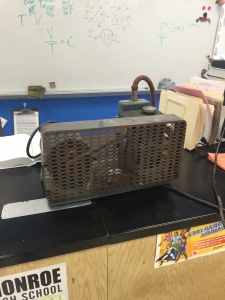I started teaching the Gas Law unit lacking inspiration. I have always considered the Gas Laws to be rote and uninspiring. My first period unit opening lesson was less than engaging. After class Mr. Smith asked me how I thought it went I said that it was less than ideal. After some discussion, and finding a vacuum pump, I scrapped my lecture plans in favor of performing Gas Law demonstrations.

Up first was to make a Gas Law manipulative. This can be used to determine what will happen to a particular variable in a Gas Law problem when another variable is controlled for. Students enjoyed making these, and several of them used them throughout the duration of the unit.
Boyle’s Law was demonstrated twice, once by the students and once by myself. Students were given a cup of mini marshmallows and a medicine syringe. The marshmallows were placed inside the syringe, the tip was covered, pressure was removed from the barrel, turn contracting the marshmallows inside. This was repeated except the tip of the syringe was covered, pressure was increased and the marshmallows expanded. Next up was using the newly discovered vacuum pump and relating it to Boyle’s Law by placing snack sized bags of potato chips and whipped cream inside and seeing them inflate. This opened the discussion as to what happens when pressure is increased in relationship to volume and Boyle’s Law.

After that I a microwave oven was used to heat Ivory soap which expanded, relaying Charles’ Law that as temperature increases, so does volume. I think this demo impressed the students the most, as the change in volume of the soap is so dramatic. The resulting mass was passed around the class for all to see, touch and smell.
To finish off the day, I demonstrated Gay-Lussac’s law by heating an aluminum can with a small amount of water in it on a hot plate, and plunging it into an ice water bath to crush it, showing that as temperature decreases, so does volume. We used the The Three Levels of Chemistry organizer to show the relationship between the macro, micro and mathematical representations of all three laws.
InTASC 3, 4 & 8 best align with these activities as mastery of content knowledge and a creative learning environment were both demonstrated in this particular lesson. HLPs 15 & 16 were also used to plan for this unit of study.
Talking about science is great. Showing students science is better. Students doing real science themselves is best. I hope to always keep that at the forefront of my planning for instruction.